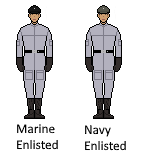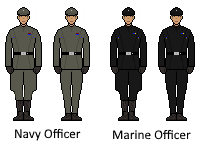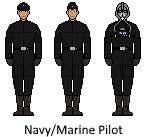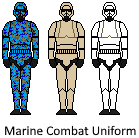NRI Republic Navy
This article is incomplete because it is pending further input from participants, or it is a work-in-progress by one author. Please comment on this article's talk page to share your input, comments and questions. Note: To contribute to this article, you may need to seek help from the author(s) of this page. |
| Novus Romanum Imperium Republic Navy | |
|---|---|
| Publica Classis | |
 Seal of the Navy | |
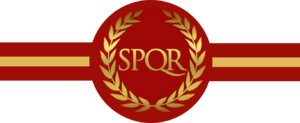 Roundel | |
| Founded | 1715 |
| Current form | The Republic Navy |
| Service branches | Territorial Water Defense Command (TWDC) Foreign Interest Defense Command (FIDC) |
| Headquarters | Naval Wing, Imperium Joint Defense Headquarters |
| Leadership | |
| Commander In Chief | Gallus Paesentius Belletor |
| Minister of the Navy | Postumius Pupius Catus |
| Navy Chief of Staff | Sextia Inda |
| Reaching military age annually | (2022) |
| Industry | |
| Domestic suppliers | Kuat Shipyards Planitia Utopia Shipyards Roman Aerospace Corp Sienar Aerospace Systems |
| Related articles | |
| Ranks | Ranks of the NRI Armed Forces |
The NRI Republic Navy was originally created as the naval fighting arm for the Roman Republic. The naval forces are made up of many fleets, both surface and subsurface, and has the responsibility of protecting the NRI's maritime interests both near Terra Nostrum and foreign. The ships are primarily supplied by the major defense conglomerates of Kuat Shipyards and Planitia Utopia Shipyards.
Ships of the Fleet
The NRI Republic Navy utilizes nearly the catalogue of vessels from the shipbuilding subsidiary of Kuat Heavy Industries. With the 26 various classes of vessels within the arsenal of the Republic Navy, a wide variety of different configurations can be made. Each major command has relative autonomy in what types of vessels they employ, as their missions are different. This has led to some unique formations in vessels, and has caused shifts from massive fleets dueling with an enemy nation to small interdiction patrols combating piracy and terrorism.
Aircraft of the Fleet
The NRI Republic Navy's air arm is made up of various aircraft. Every ship has helicopters on it which operate in an ASW role. Carriers and strike cruisers are deployed with multirole fighters as well. Additionally, all carriers are deployed with AWACS. The Republic Navy also operate auxiliary aircraft as well.
History
Major Commands
The NRI Republic Navy is split into 2 major commands: Territorial Water Defense Command (TWDC) and Foreign Interest Defense Command (FIDC). Both commands are semi-autonomous and though they have the same overarching mission of protecting the Roman's maritime interests, they have latitude in how they accomplish that.
Territorial Water Defense Command
The Territorial Water Defense Command (TWDC) has the responsibility to defend the NRI from the shores of Terra Nostrum to the end of the exclusive economic zone (EEZ), which extends 300 nmi from the coast of the NRI. Additionally, the TWDC has the responsibility to responding to maritime distress of civilian vessels. This has led to some likening the TWDC to a "militarized coast guard". This in many respects is true because the TWDC shares many of the missions as a traditional coast guard.
To accomplish their missions, the TWDC has set up 9 fleets of varying size. These fleets are the Lake Fleet, Mare Neptune Fleet, Mare Antonia Fleet, Mare Salacia Fleet, Island Fleet, Northern Fleet, Eastern Fleet, Western Fleet, and EEZ patrol fleet.
The TWDC is broken into subcommands. These are EEZ Patrol Command, Fresh Water Command, Subsurface Command, Air Command, and Marine Command.
Foreign Interest Defense Command
The Foreign Interest Defense Command (FIDC) is more closely aligned to a traditional navy than a coast guard. This command is responsible for defending the Roman interests from beyond the 300 nmi economic exclusion zone. This gargantuan navy is largely nuclear powered, allowing ships to stay on patrol for as long as the sailors can be on patrol.
The FIDC is broken into subcommands. These are Surface Command, Subsurface Command, Air Command, Marine Command.
Marines
The Republic Navy's marines were created back in its inception in 1715 as naval infantry. These forces would shoot at marines and sailors of enemy ships in combat, and would perform boarding operations. In their modern inception, the marines largely keep this role. In addition to this historical responsibility, they are also responsible for providing security on naval ships and installations. The weaponry of the naval marines are the same as those used by the Republic Army, for ease of logistics.
Uniforms
Enlisted Republic Naval personnel are issued a grey jumpsuit as their standard working uniform. A black belt with silver buckle is also worn around the waist. Gauntlet-style gloves and black boots are also issued with the uniform. A grey-green cap is issued for the headwear. The exception are marine personnel, who have a black cap issued instead. Ranks are placed on the sleeve.
Republic Navy officers are issued a grey-green uniform that has straight pants with black chelsea boots. They also have a matching color cap, black belt with silver buckle, and black leather gloves. The dress variant of the uniform replaces the stright pants with Jodhpur style pants and English style riding boots. Marine officers wear the same uniform, except the fabric color is black. Ranks are placed on the upper left side of the chest
If the officer needs to wear a uniform that is better suited for physical labor, they don an enlisted style jumpsuit with their officer rank emblazoned on the chest.
Officers of rank O-7 and above trade in their grey-green or black uniforms for pure white uniforms with gold shoulder boards.
Republic Naval Intelligence personnel, both enlisted and officer wear similar uniforms to the officers. The difference is that they wear a cream-color tunic with black pants and boots. The same Jodhpur/riding boot, straight pant/chelsea boot configurations exist for this uniform as well. Officers wear their rank on the upper left side of their chest, while enlisted personnel have it on their sleeve.
The pilots wear the same uniform. They wear a black flightsuit with a black cap of the same style as the officer, along with black boots and a black belt and silver buckle. They also have the option of wearing a black garrison cap instead of the officer's cap. As all the pilots are officers, they wear their ranks on the upper left chest. In flight, they don a helmet, which connects to a chest rig. The chest rig is hooked into oxygen lines in the cockpit of the aircraft.
Marine Combat
During their interdiction, boarding, and guard duties, the marines wear a full set of body armor and a helmet. The armor comes in three variants: blue camo, tan, and white. The white armor is used exclusively for guard duty in formal government areas, like the Senate and Imperial Palace. Tan is the general guard armor, and blue camo is used in interdiction and boarding operations. There has been a lot of controversy with the use of a full helmet due to limited visibility. Due to that limitation, a lot of guard units forgo it while on guard duty, wearing the marine cap instead.
Cadet
Cadets at the Roman Naval Academy at Castra Romulus wear uniforms of the same grey-green color as naval officers. The cut of the tunic, however, is slightly different, with thick brown cuffs. The uniform is issued with a hat of matching color, matching straight pants, chelsea boots, and a black belt with silver buckle.
